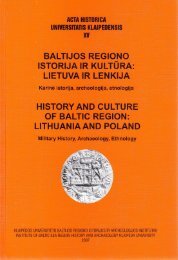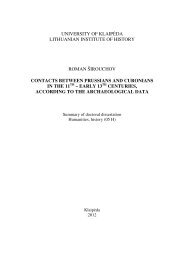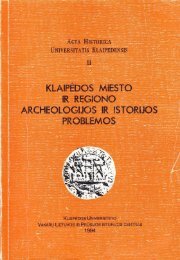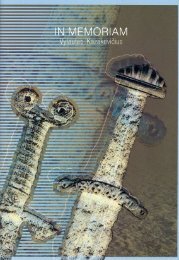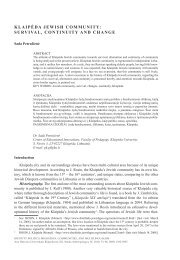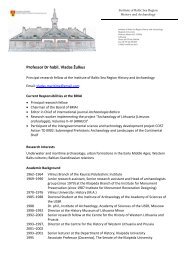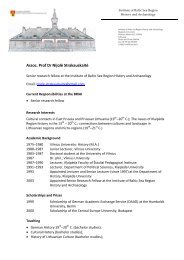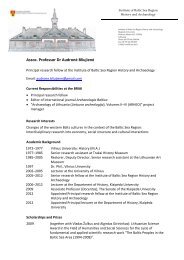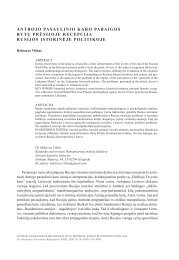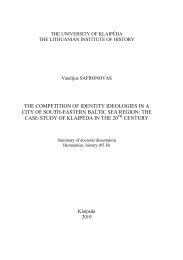See summary of dissertation in English - Baltijos regiono istorijos ir ...
See summary of dissertation in English - Baltijos regiono istorijos ir ...
See summary of dissertation in English - Baltijos regiono istorijos ir ...
You also want an ePaper? Increase the reach of your titles
YUMPU automatically turns print PDFs into web optimized ePapers that Google loves.
Brew<strong>in</strong>g, milk process<strong>in</strong>g and gra<strong>in</strong> mill<strong>in</strong>g widely spread at<br />
Samogitian manors and mills spread to a considerably lesser degree<br />
were attributed to the f<strong>ir</strong>st type. Even though the process<strong>in</strong>g <strong>of</strong> raw<br />
materials was rather widely spread, it was carried out by means <strong>of</strong><br />
rather primitive production methods at the manor. Even though <strong>in</strong><br />
some cases the improvement <strong>of</strong> technologies may be observed, e.g.<br />
the use <strong>of</strong> water mills or the work <strong>of</strong> brewers (apparently pr<strong>of</strong>essional),<br />
etc, we still have too little data to speak about larger pr<strong>of</strong>its<br />
generated from them.<br />
The sell<strong>in</strong>g <strong>of</strong> alcoholic beverages and saloon bus<strong>in</strong>ess is attributed<br />
to the second type. Even though it was developed on the territory belong<strong>in</strong>g<br />
to the manor, historians do not consider it a typical manorial<br />
craft. The f<strong>ir</strong>st reason is that saloons were considered craftsmen enterprises,<br />
where alcoholic beverages were not only sold but also produced,<br />
and, secondly, such activities were rather strongly regulated by<br />
the provisions and legal acts <strong>of</strong> the grand duke.<br />
6. The research carried out <strong>in</strong> the thesis revealed that Samogitia,<br />
be<strong>in</strong>g a typical part <strong>of</strong> the periphery <strong>of</strong> the European economy, participated<br />
<strong>in</strong> the European economic conjuncture <strong>of</strong> that time as one <strong>of</strong><br />
its typical territories. From the very orig<strong>in</strong>s <strong>of</strong> development <strong>of</strong> the<br />
allodium Samogitia witnessed the phenomena <strong>of</strong> land-ownership development<br />
characteristic <strong>of</strong> Central European region. Depend<strong>in</strong>g on<br />
the location and macroeconomic conditions, certa<strong>in</strong> specific features<br />
emerged <strong>in</strong> land-ownership relations correct<strong>in</strong>g the place <strong>of</strong> Samogitia<br />
<strong>in</strong> European and Central European regional economic context.<br />
The study shows that by contrast to the prevail<strong>in</strong>g op<strong>in</strong>ion to this<br />
day the manors that complied with the Central European economic<br />
manor model and developmental characteristics were founded <strong>in</strong><br />
Samogitian private land-ownership <strong>in</strong> the 16 th century. The general<br />
structure <strong>of</strong> the<strong>ir</strong> manors and economic organisation testify the<strong>ir</strong> orientation<br />
towards the production <strong>of</strong> agricultural raw materials, such as<br />
gra<strong>in</strong> crops and livestock products, which were particularly popular <strong>in</strong><br />
foreign markets at that time. Apart from them, hay production, forestuse,<br />
fishery, beekeep<strong>in</strong>g, process<strong>in</strong>g <strong>of</strong> manorial raw materials and<br />
48



